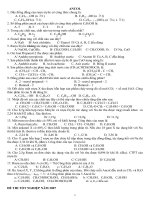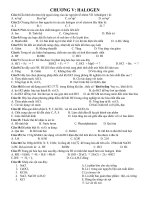Đề cương trắc nghiệm Hành Vi Tổ Chức (Organizational Behavior) CHƯƠNG 15
Bạn đang xem bản rút gọn của tài liệu. Xem và tải ngay bản đầy đủ của tài liệu tại đây (45.67 KB, 14 trang )
Chapter 15: Organizational Change and
Development
15-1. As the web of computer networks expands, the distance will shrink
and eventually become irrelevant. This refers to
a. the force field analysis.
b. the law of telecosm.
c. incongruent organizational system.
d. mankind's deterioration due to technology.
e. the law of effect.
The question was not answered. The correct answer is "b".
15-2. All of these factors have played a role in increasing global and
local competition except
a. technology.
b. government deregulation.
c. diversity.
d. privatization.
e. All of these factors have played a major role in increasing global and
local competition.
The question was not answered. The correct answer is "c".
15-3. Which of these best describe the restraining forces?
a. Unfreezing
b. Driving forces
c. Negotiation
d. Refreezing
e. Resistance to change
The question was not answered. The correct answer is "e".
15-4. Which of these is the first part of the change process, according to
Lewin's model?
a. Unfreezing
b. Driving forces
c. Negotiation
d. Refreezing
e. Resistance to change
The question was not answered. The correct answer is "a".
15-5. The main reasons why people create obstacles to change include
all of these except
a. direct costs.
b. poor leadership.
c. breaking routine.
d. fear of unknown.
e. saving face.
The question was not answered. The correct answer is "b".
15-6. When people resist change as a political strategy to "prove" that
the decision is wrong or that the person encouraging change is
incompetent refers to which of these forces resisting organizational
change?
a. Direct costs
b. Poor leadership
c. Breaking routine
d. Incongruent organizational system
e. Saving face
The question was not answered. The correct answer is "e".
15-7. The preferred option under the unfreezing stage is
a. increase the restraining forces.
b. increase the driving forces.
c. reduce the driving forces.
d. reduce or remove the restraining forces.
e. both b and d.
The question was not answered. The correct answer is "e".
15-8. All of these methods try to reduce the restraining forces except
a. stress management.
b. negotiation.
c. communication.
d. employee involvement.
e. training.
The question was not answered. The correct answer is "b".
15-9. Which of these is the highest priority and first strategy required for
any organizational change?
a. Communication
b. Stress management
c. Negotiation
d. Training
e. Employee involvement
The question was not answered. The correct answer is "a".
15-10. Which of these methods for dealing with resistance to change
creates a psychological ownership of the decision?
a. Communication
b. Stress management
c. Negotiation
d. Training
e. Employee involvement
The question was not answered. The correct answer is "e".
15-11. __________ are system-wide group sessions, usually lasting a
few days in which participants identify environmental trends and
establish strategic solutions for these conditions.
a. Negotiations
b. Training
c. Search conferences
d. OD
e. Stress management sessions
The question was not answered. The correct answer is "c".
15-12. Organizational change is, in large measure, a
a. social activity.
b. cruel activity.
c. training activity.
d. political activity.
e. None of these.
The question was not answered. The correct answer is "d".
15-13. The adage "What gets measured, gets done" applies in which of
these stages?
a. Changing to the desired future state
b. Unfreezing
c. Refreezing
d. Restraining forces
e. All of these.
The question was not answered. The correct answer is "c".
15-14. Change agents are typically people
a. within the organization.
b. who are transformational leaders.
c. with appropriate knowledge for change.
d. with power to facilitate the change effort.
e. All of these.
The question was not answered. The correct answer is "e".
15-15. __________ is a database, problem-oriented process that
diagnoses the need for change, introduces the OD activity, and then
evaluates and stabilizes the desired changes.
a. Process consultation
b. Action research
c. Quantum change
d. Sensitivity training
e. Organizational incongruency
The question was not answered. The correct answer is "b".
15-16. The organizational development process begins by
a. forming a relationship between the client and consultant.
b. diagnosing the need for change.
c. introducing change.
d. evaluating change.
e. initiating sensitivity training.
The question was not answered. The correct answer is "a".
15-17. Which of these involves helping the organization solve its own
problems by making it aware of organizational processes, the
consequences of those processes and the means by which they can be
changed?
a. Organizational diagnosis
b. Sensitivity training
c. Force field analysis
d. Process consultation
e. Search conferences
The question was not answered. The correct answer is "d".
15-18. __________ is an unstructured and agendaless session in which
participants become more aware through their interactions of how they
affect others and how others affect them.
a. Organizational diagnosis
b. Sensitivity training
c. Force field analysis
d. Process consultation
e. Search conferences
The question was not answered. The correct answer is "b".
15-19. Which of these is true of parallel learning structures?
a. They are highly participative arrangements
b. They involve people from most levels of the organization who follow
action research model to produce change
c. They are social structures
d. Participants are sufficiently free of the constraints of the larger
organization
e. All of these.
The question was not answered. The correct answer is "e".
15-20. Which of these is the first stage of the appreciative inquiry?
a. Delivery
b. Dialogue
c. Discovery
d. Designing
e. Dreaming
The question was not answered. The correct answer is "c".
TRUE or FALSE
15-1. Force field analysis includes driving forces and restraining forces.
True / False
The question was not answered. The correct answer
is "True". (Coaching responses are only available for answered
questions)
15-2. Driving forces represent the booster rockets that pushes employees
out of their comfort zones.
True / False
The question was not answered. The correct answer
is "True". (Coaching responses are only available for answered
questions)
15-3. Change agents minimize resistance to change introducing
restraining forces and removing driving forces.
True / False
The question was not answered. The correct answer
is "False". (Coaching responses are only available for answered
questions)
15-4. People sometimes resist change because they are worried that they
cannot adapt to the change.
True / False
The question was not answered. The correct answer
is "True". (Coaching responses are only available for answered
questions)
15-5. After the desired change has occurred, the change agent needs to
unfreeze the new conditions.
True / False
The question was not answered. The correct answer
is "False". (Coaching responses are only available for answered
questions)
15-6. Employee involvement is the highest priority and first strategy
required for any organizational change.
True / False
The question was not answered. The correct answer
is "False". (Coaching responses are only available for answered
questions)
15-7. Search conferences minimize resistance to change mainly as a
form of stress management.
True / False
The question was not answered. The correct answer
is "False". (Coaching responses are only available for answered
questions)
15-8. Effective change agents are transactional leaders.
True / False
The question was not answered. The correct answer
is "False". (Coaching responses are only available for answered
questions)
15-9. Most OD activities rely on action research as the primary blueprint
for planned change.
True / False
The question was not answered. The correct answer
is "True". (Coaching responses are only available for answered
questions)
15-10. Process consultation occurs when the OD consultant helps the
organization solve its own problems.
True / False
The question was not answered. The correct answer
is "True". (Coaching responses are only available for answered
questions)
15-11. OD processes today almost exclusively focus on interpersonal
and small group dynamics rather than macro-organizational changes.
True / False
The question was not answered. The correct answer
is "False". (Coaching responses are only available for answered
questions)
15-12. A parallel learning structure is a highly participative social
structure alongside the formal organization constructed to improve
organizational learning.
True / False
The question was not answered. The correct answer
is "True". (Coaching responses are only available for answered
questions)
15-13. Sensitivity training is one of the emerging trends in organization
development.
True / False
The question was not answered. The correct answer
is "False". (Coaching responses are only available for answered
questions)
15-14. Appreciative inquiry takes the view that organizational change
involves identifying problems and who caused these problems.
True / False
The question was not answered. The correct answer
is "False". (Coaching responses are only available for answered
questions)









